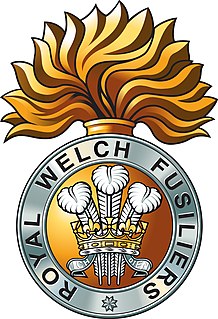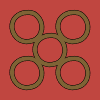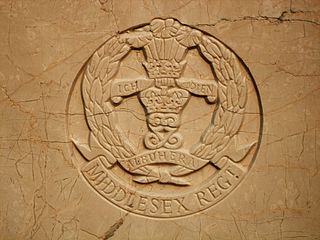
The Royal Welch Fusiliers was a line infantry regiment of the British Army and part of the Prince of Wales' Division, founded in 1689 shortly after the Glorious Revolution. In 1702, it was designated a fusilier regiment and became The Welch Regiment of Fusiliers; the prefix "Royal" was added in 1713, then confirmed in 1714 when George I named it The Prince of Wales's Own Royal Regiment of Welsh Fusiliers. After the 1751 reforms that standardised the naming and numbering of regiments, it became the 23rd Foot.

The 53rd (Welsh) Infantry Division was an infantry division of the British Army that fought in both the First and Second World Wars. Originally raised in 1908 as the Welsh Division, part of the Territorial Force (TF), the division saw service in First World War, being designated 53rd (Welsh) Division in mid-1915, and fought in the Gallipoli Campaign and in the Middle East. Remaining active in the Territorial Army (TA) during the interwar period as a peacetime formation, the division again saw action in Second World War, fighting in North-western Europe from June 1944 until May 1945.

The First Battle of Gaza was fought on 26 March 1917, during the first attempt by the Egyptian Expeditionary Force (EEF) to invade the south of Palestine in the Ottoman Empire during the Sinai and Palestine Campaign of the First World War. Fighting took place in and around the town of Gaza on the Mediterranean coast when infantry and mounted infantry from the Desert Column, a component of the Eastern Force, attacked the town. Late in the afternoon, on the verge of capturing Gaza, the Desert Column was withdrawn due to concerns about the approaching darkness and large Ottoman reinforcements. This British defeat was followed a few weeks later by the even more emphatic defeat of the Eastern Force at the Second Battle of Gaza in April 1917.

160th (Welsh) Brigade or Brigâd 160 (Cymru), is a regional brigade of the British Army that has been in existence since 1908, and saw service during both the First and the Second World Wars, as part of the 53rd (Welsh) Infantry Division. It is a regional command responsible for all of Wales. The Brigade is also regionally aligned with the Eastern European and Central Asian regions as part of defence engagement.

The 32nd Division was an infantry division of the British Army that was raised in 1914, during the First World War. The division was raised from volunteers for Lord Kitchener's New Armies, made up of infantry 'Pals battalions' and artillery brigades raised by public subscription or private patronage. The division was taken over by the War Office in September 1915. It served in France and Belgium in the trenches of the Western Front for the duration of the war. It saw action at the Battle of the Somme, the Pursuit to the Hindenburg Line, the Defence of Nieuport, the German spring offensive, and the Allied Hundred Days Offensive beginning at the Battle of Amiens. After the Armistice it marched into Germany as part of the Army of Occupation.

The Cheshire Regiment was a line infantry regiment of the British Army, part of the Prince of Wales' Division. The 22nd Regiment of Foot was raised by the Duke of Norfolk in 1689 and was able to boast an independent existence of over 300 years. The regiment was expanded in 1881 as part of the Childers Reforms by the linking of the 22nd (Cheshire) Regiment of Foot and the militia and rifle volunteers of Cheshire. The title 22nd (Cheshire) Regiment continued to be used within the regiment.

The King's Shropshire Light Infantry (KSLI) was a light infantry regiment of the British Army, formed in the Childers Reforms of 1881, but with antecedents dating back to 1755. It served in the Second Boer War, World War I and World War II. In 1968, the four regiments of the Light Infantry Brigade amalgamated to form The Light Infantry, with the 1st KSLI being redesignated as the 3rd Battalion of the new regiment.
The 158th Infantry Brigade was an infantry brigade of the British Army that served in both the First and Second World Wars, before being disbanded in 1968. Throughout its existence the brigade was assigned to the 53rd (Welsh) Infantry Division and was composed almost entirely of Territorial battalions from the Royal Welch Fusiliers.

The Monmouthshire Regiment was an infantry regiment of the British Army and the Territorial Army. Originating in units of rifle volunteers formed in Monmouthshire in 1859, the regiment served in the Second Anglo-Boer War and both World War I and World War II before losing its separate identity in 1967.

The Essex Brigade, later 161st Brigade and 161st Infantry Brigade, was a volunteer infantry formation of the British Army in existence from 1888 until 1941, and again from 1947. It served at Gallipoli and in Palestine during the First World War and returned to Egypt in the early part of the Second World War before transferring to the British Indian Army and redesignated 161st Indian Infantry Brigade. In peacetime and during the wars the brigade was an integral part of the 54th Infantry Division and contained mostly battalions of the Essex Regiment.
The 153rd Punjabis – also designated 153rd Rifles, see nomenclature (below) – was an infantry regiment of the British Indian Army. It was formed in Mesopotamia and Palestine in May 1918, saw service in the Sinai and Palestine Campaign in the First World War, and was disbanded in June 1922.
The Cheshire Artillery Volunteers was a brigade of Volunteer artillery units raised in the county of Cheshire in the mid-19th Century. Their successors served as field artillery in Palestine during World War I and as anti-aircraft (AA) gunners in the Middle East in World War II. They continued in the air defence role in the Territorial Army until 1955.

The 2nd Welsh Brigade was a Royal Field Artillery unit of Britain's Territorial Force (TF) formed in 1908 that served in Palestine during World War I. Between the wars it converted to the anti-aircraft (AA) role and was captured in Java during World War II. Its successor unit continues in Britain's Army Reserve today.

The 1st Glamorganshire Artillery Volunteers was formed in 1859 in response to a French invasion threat. Formed as a coast artillery unit, it later became part of the Royal Field Artillery in the Territorial Force and served during both World Wars until amalgamated in 1961.

The 10th Battalion, Middlesex Regiment, was an infantry unit of Britain's Territorial Force from 1908 to 1920. Based in Ravenscourt Park, West London, its part-time soldiers saw service at Gallipoli, in Palestine, and on the Western Front during World War I. After the war the battalion was amalgamated into a unit of the new Royal Corps of Signals.
The 6th Battalion, Cheshire Regiment, was a Territorial Force (TF) unit of the British Army. Formed in 1908 from Volunteer units recruited in Cheshire since 1859, it was one of the first TF units to go to the Western Front in World War I. It had a wandering existence, moving frequently from one command to another, seeing a considerable amount of combat at the Somme, Ypres, during the German spring offensive and in the final Allied Hundred Days Offensive. After the war it was amalgamated into a local artillery regiment.
The 1st Flintshire Rifle Volunteers, later 5th (Flintshire) Battalion, Royal Welch Fusiliers, was a Welsh unit of the British Army's auxiliary forces. First raised in 1860, it fought as infantry at Gallipoli), in Egypt and Palestine during World War I. Converted to the anti-tank role, it fought in the Battle of France, the Western Desert and Italy in World War II. It continued in the postwar Territorial Army until amalgamated with a neighbouring unit in 1956.

The 6th Battalion, Royal Welch Fusiliers, was a Welsh unit of the British Army's auxiliary forces. Formed in 1908, from Volunteer units that dated back to 1860, it fought at Gallipoli), in Egypt and Palestine during World War I, and in the campaign in North West Europe during World War II. Postwar it was converted to the anti-aircraft artillery role, then reverted to infantry in 1956 after it amalgamated with a neighbouring unit.
The 1st Denbighshire Rifle Volunteers, later 4th (Denbighshire) Battalion, Royal Welch Fusiliers, was a Welsh unit of the British Army's auxiliary forces. First raised in 1860, it served as a pioneer battalion with the 47th Division on the Western Front during World War I and with the 53rd (Welsh) Division in North West Europe during World War II. It continued in the postwar Territorial Army through a series of mergers until finally amalgamating with another Welsh battalion in 1999.

The 7th Battalion, Royal Welch Fusiliers, was a Welsh unit of Britain's Territorial Force. First raised in 1897, it fought at Gallipoli and in Palestine during World War I, and in the campaign in North West Europe during World War II. A duplicate battalion was converted to the paratroop role. Postwar the battalion was converted into anti-aircraft artillery, then reverted to infantry in 1956 after it amalgamated with a neighbouring unit.















